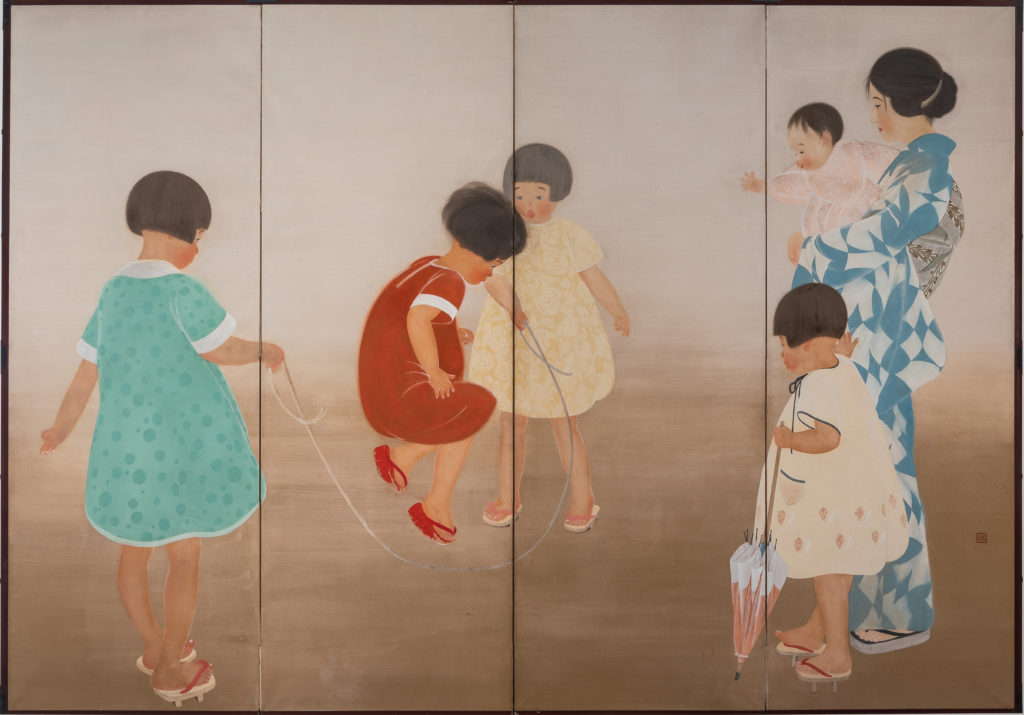Learn More
Learn more about the artists and artwork featured in Moga: Modern Women & Daughters in 1930s Japan. Writing and research contributed by Gallery Assistant Emeline Boehringer and Curatorial Associate Ashley Janke.
Artists
Itō Shinsui (1898 - 1972)
Itō Shinsui (born Itō Hajime) was one of 20th century Japan’s most famous painters. The pseudonym “Shinsui” (meaning “deep water”) was given to the artist by his mentor Kaburaki Kiyokata—a painter, printmaker, and master of bijin-ga (“images of beautiful women”) who began teaching the young Shinsui in 1911. Kiyokata passed on his knowledge of Edo-period ukiyo-e style to Shinsui, who would become famous for his combination of Edo tradition with modern elements, spearheading the revival of Shin Hanga (“new prints”) in Japan during the Taishō and Shōwa periods. Like Kiyokata, Shinsui became particularly famous for his depictions of beautiful women.
Shinsui’s prints became especially popular abroad thanks to his partnership with Shōzaburō Wantanabe, a print publisher who marketed Shinsui’s prints to the West. Shinsui produced over 100 unique print designs for Wantanabe’s print company, including his famous Twelve Figures of Modern Beauties (1922). Shinsui’s prints were often made from watercolor originals, and his mastery of painting was what earned him domestic fame. By the end of World War II, Shinsui was very well known in Japanese society. His work was declared “intangible cultural property” in 1952, and he was named to the Order of the Rising Sun in 1970, a recognition of his distinguished contribution to Japanese culture.
Enomoto Chikatoshi (1898 - 1973)
Enomoto Chikatoshi was a prolific painter of nihonga, especially known for images of modern women (moga) engaged in sport. Many of Chikatoshi’s images depict women skiing against a snowy backdrop, evidence of the sport’s growing popularity in Japan in the late 1930s.
⠀⠀⠀ ⠀⠀⠀⠀
The increasing popularity of women’s sport in particular was bolstered by Japan’s intention to host the unrealized 1940 Olympic Games, as well as the efforts of the Japanese railway system to specifically promote ski travel as a fashionable leisure activity. Chikatoshi made advertisements for the Railway Ministry (Tetsudōshō) to promote skiing and also participated in the 1932 Olympic Art Competition held in concert with the Los Angeles Olympics, where his work was exhibited alongside other Japanese artworks at the Los Angeles Museum of History, Science, and Art.
⠀⠀⠀ ⠀⠀⠀⠀
A version of the painting shown here, Chikatoshi’s Lady with Terrier on Leash, was displayed next to the artist’s depictions of women engaged in sport near the entrance of the Meguro Gajoen. Like Chikatoshi’s skiiers, the subject of Lady with a Terrier on Leash is active, yet carefully composed and far from exertion. The tension created by the dog, likely a Wire Fox Terrier, pulling its own leash taut is countered by the woman’s cool expression and restrained movement. Reflective silver in the background creates an impression of wintry cold and highlights the woman’s stylish silver barrette and earring.
Artworks
Afternoon Visitor (Early Showa Era), Sekiguchi Masao
“Afternoon Visitor” depicts a young woman seated next to a flower bouquet and teal-colored handbag. Whether the woman is the “afternoon visitor” referenced in the painting’s title herself or is receiving another is unclear. This ambiguity is enhanced by the fact that the woman seems to be focusing her attention on someone or something off to the right of the painting, unavailable to the viewer. The featureless background heightens the sense of mystery while focusing the eye on the fine detail that animates every part of the woman’s appearance—her patterned kimono, her slightly wavy hair, and her dramatic black lace gloves. The tension between information and ambiguity, the known and the unknown, within the picture, creates a sense of anticipation that goes unanswered by the painting’s composition.
However, this tension also focuses attention on details left by the painter, some of which reflect a conscious inclusion of Western items. In particular, the woman’s black lace gloves with a “gauntlet” cuff design are similar to styles that became popular in the United States and France beginning in the 1920s. Her semi-permed hair is also reminiscent of Western styles popularly adopted by moga. The subdued nature of these references may point to changing expectations of women’s sexuality in 1930s Japan—a time in which the relative sexual freedom of moga was increasingly replaced with the expectation that women present an ideal of chastity and restraint.




